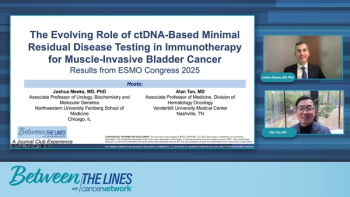
Expert Perspectives and Best Practices for Managing Ocular Adverse Events in Ovarian Cancer
Panelists discuss how managing ADC-related ocular toxicity requires vigilance through slit-lamp exams and visual acuity testing, with early intervention including treatment holds or dose reductions being essential to prevent long-term damage, while emphasizing the need for collaborative decision-making between oncologists and ophthalmologists to balance cancer control with reversible side effects and maintain patient quality of life.
Episodes in this series

Key Considerations in Monitoring ADC-Related Eye Toxicities
Managing ocular toxicity from ADCs requires vigilance and expertise. Common issues include corneal changes and blurred vision, often identified through slit-lamp exams and visual acuity testing. Early intervention—such as treatment holds or dose reductions—is essential to prevent long-term damage.
There’s debate about whether to reduce the dose at grade 1 toxicity to prevent escalation. While such an approach may protect vision, it must be balanced against maintaining cancer control. Additionally, the use of steroid eye drops, while helpful, may contribute to cataract development, highlighting the need for careful oversight.
Most eye-related side effects from ADCs are reversible. Collaborative decision-making between oncologists and ophthalmologists helps balance treatment efficacy with patient safety. Patient-reported symptoms should guide timely dose modifications and ensure ongoing quality of life during therapy.
Newsletter
Stay up to date on recent advances in the multidisciplinary approach to cancer.
















































































